
|
The world of non-commercial film and A-V |
Events Diary | Search | ||
| The Film and Video Institute | | ||||
The making of The Release
Meet ... the Partners
whose film The Release won an International Standard Award & Best Editing Prize at BIAFF 2007
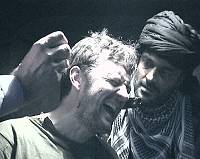 |
The film tells the story of British agent Finn Newman sent on a mission to Afghanistan. Finn is captured by the Taliban and under torture betrays his colleague, Alan. After escaping to London, Finn seeks to revive the relationship with his former girlfriend. Meanwhile Finn's guilt makes him contact Alan's family disturbing senior officers and politicians. |
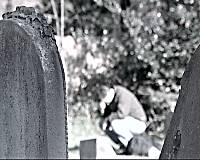 |
Terry Tkachuk, John W. James, Neville Withers and Karen Cherrington are the heart of the Partners Team having produced successes like Partners, Dirty Style Blues and now The Release. Their latest low-budget movie is a tour-de-force. Its making is documented on their website with a production diary and a short film about the production, called Balls in the Air - a title which reflects the task of the director in any large production keeping everything under control.
As the SERIAC crew were de-rigging screens, packing equipment and tidying up, I gathered the director, Alan Robison, and several of the Partners round a suitably shadowed table to discuss this movie of intrigue and dark forces. They were marvelous. My mini-disk was not and I had to take notes. I would never earn a place in their highly proficient team.
Control, order, planning
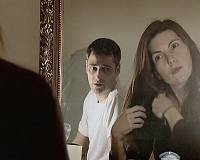 |
Those concepts do not figure much in most amateur movies but they do
in Partners productions. By themselves they raised a budget of £6,000.
Another £1000 was set aside as contingency to allow for any over-runs
and unforeseen problems. A further £500 was prepared for publicity,
promotions and costs of festival entries.
The budget had to pay for actors' expenses, catering, location scouting, equipment hire, music fees and tape costs. This meant that financial control was crucial. Having to shoot a 43 minute film at weekends and in spare time meant complicated juggling of calendars and organising skills. It also meant calling on a lot of trusted friends for help. |
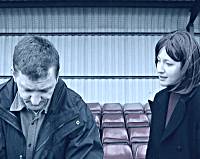 |
John James worked on editing and location sound recording, John Lofting was recruited for his camera skills and Karen Cherrington handled administration and script continuity. Neville Withers did the driving and grips jobs. Terry Tkachuk acted as line-producer to ensure the film was made to time and budget. Actors had to be auditioned and cast, rehearsal time had to be arranged and schedules had to fit round their availability.
The basic story-line about a character needing salvation was pitched by director Alan Robinson in 2003. But the concept was reworked into an entirely new form by writer Terry Tkachuk. The pair spent a year developing and re-writing the story. The full team was then brought in. Meticulous planning helped reduce costs as, for example requesting one actor to play two parts - a Taliban fighter and a struggling UK musician. Costs were also saved when grip Neville Withers played a Guard swinging a rifle-butt at the hapless hero.
Casting began in 2004 and shooting started in early 2005.
Writing
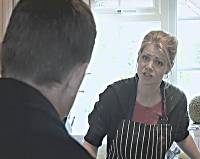 Writing is often dismissed as a trivial element in a production
because it involves people working quietly out of sight. And yet it is at
the heart of any good movie. For Terry Tkachuk writing a movie is a long
process of revision, discussion, bouncing ideas off fellow writers, his film
director and later the actors in rehearsal. It means recognising that some
things work on the page and not on screen and vice-versa. Terry outlined
the schedule:
Writing is often dismissed as a trivial element in a production
because it involves people working quietly out of sight. And yet it is at
the heart of any good movie. For Terry Tkachuk writing a movie is a long
process of revision, discussion, bouncing ideas off fellow writers, his film
director and later the actors in rehearsal. It means recognising that some
things work on the page and not on screen and vice-versa. Terry outlined
the schedule:
- " Alan's original story-line discussed October 6th 2003.
- " Treatment: February 24th 2004.
- " First draft completed: April 23rd 2004.
- " First revisions begun: June 2004.
- " Final revisions and polishing completed: January 31st 2005.
"It's taken over a year but by draft twenty I had earned the right to tell a story that the audience could be drawn into. Yet writing for the screen is a strange thing: a screenplay cannot supply the excitement of good acting or the raw emotion of music. It is now up to Alan, the cast and partners to bring the screenplay to life."
Best laid plans
Of course no shoot ever runs entirely to plan. One of the principal actresses was injured in a hit-and-run car accident days before her scenes were due and someone else had to be found. Another voice did not sound quite right so the lines were dubbed rather than organising a re-shoot.
In his video diary, Alan Robinson comments to camera that "You can work on the script as much as you can; you cast the actors, get the locations and props, but once I call action for the first time this morning ... it's all going to be about keeping the balls in the air. "
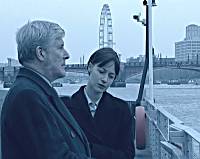 |
Shooting on the streets of London had to be done as a guerrilla exercise
to avoid the bureaucracy and ludicrous insurance cover demanded by the
authorities. That meant sometimes shooting from one bank of the Thames, action
on a pier at the other side - cueing the performers by radio or mobile phone.
Only to find tourist boats arriving at the floating landing-stage where the
camera was set up.
At one point while shooting on the river a patrol boat came close to the actors. Quick-thinking Robin Ingram, playing the experienced politician, added an unscripted greeting to them which accorded perfectly with his character's populist charm masking a ruthless ambition. |
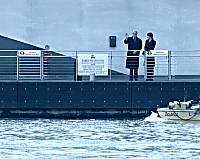 |
Location, location, location
How do you shoot an interrogation scene supposedly in remote Afghan caves when airplanes and traffic regularly intrude of the soundtrack? You shoot in short bursts!
 |
The cast and crew covered a lot of ground to
find suitable locations, a flock of goats, murky railway arches and so on
- all the way from London suburbs to Snowdonia. One unexpectedly difficult
location to find was the one standing in for the Salang Tunnel in Afghanistan.
It was Beaminster in rural west Dorset which eventually provided this remote
Afghan location. But between scouting and filming the grass around had shot
up!
Wales and England were again used to double for Afghanistan by virtue of clever angles and a post-production colour grading which removed the lush green of hills and valleys. Compare the goats on the left filmed in Beaconsfield with the way the flock appear in the movie on the right. (Shots from Balls in the Air - a movie about the making of The Release.) In Snowdonia the team brought tents, costumes and props to dress the scenes. Ironically on their way home they found that just over the pass was an encampment of Muslims in traditional dress which would have been perfect for the shoot. Borrowing a flat from friends is one way to get the right feel for place ... but becomes tricky if your leading character has to bash holes in the wall. A mock-up wall of light plasterboard was provided for the benefit of both actor and homeowners. |
|
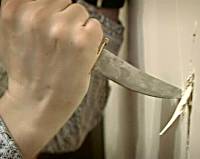 |
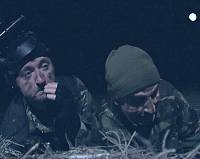 |
Sound and music
A hallmark of Partners Productions has been the care paid to the soundtrack. Some scenes had to be dubbed either because the action was too far away to be recorded satisfactorily or because of extraneous noise. This often meant recording dialogue in an aurally suitable location which could be miles from where the original scenes were shot. Nick Magnus was approached for a score. He had a deadline of 6 weeks and came up with themes which the team loved. His synthesizer score suggested the "wailing sounds" of Afghan Nomads but with thunderous rhythms to build tension and pace. .
Getting it seen
There is a great hurdle for all low/no-budget movies - how to get it seen. You can, of course, put it on the web but the quality of image is rarely satisfactory. Taking it round festivals is another route but time-consuming. Winning International Standard and Best Editing in BIAFF 2007 is a pretty good start. The team have European and American Festivals in their sights.
The drama's core is the moral dilemma of Finn, a fallible man doing his best. Yet there is a strong political undercurrent about the duplicitous nature of governments and the current East-West divide. The movie ends with a quotation from Japanese poet and painter, Yosa Buson:
"Wind in the west
Fallen leaves
Gathering in the east."
 But I suspect another of his haiku also informed the script:
But I suspect another of his haiku also informed the script:
"Paper kite
in the same part of the sky
it was yesterday"
for the film begins and ends in a park and throughout there are flashbacks of a small boy playing with a kite. The final picture of the film is of Finn flying a box kite lined with the cash he regards as blood money.
"All real £50 notes", Karen told me in voice suggesting she did not quite believe she had allowed that scene to risk literally blowing the budget away.
The whole team grinned at that - it seemed to sum them up. On the one hand careful, even meticulous about the project and on the other recognising that making a film is making a dream - it requires a certain amount of vital glee in attempting the impossible and taking chances.
- Dave Watterson
Links:
- Read the film maker's diary on Terry Tkachuk's website
- Watch Balls in the Air a documentary about making the film on YouTube.
Share your passions.

Share your stories.
